Displaying items by tag: squib
Kinsale Yacht Club Frostbite Series Produces Squib 'Battle Royale'
#kinsalesailing – The forecast for the penultimate day's racing of Kinsale YC's ASM sponsored Frostbite series indicated that there may not be any racing as winds of up to 40 knots were predicted. Many competitors failed to show up as they were convinced that racing would be abandoned.
However race officials managed to get 2 full races underway. The first race started with 12 knots gusting to 17 knots from the South West. Winds increased for the second race, the committee boat measured 16 knots with gusts of 22 knots prior to the start but once the race was underway, gusts rose to 28 knots. The sea was quite calm and fortunately the rain stayed away during racing.
The Lasers raced as one fleet and fresh conditions enabled the solitary Laser Radial sailor (188047 Charlie Moloney) to equally match his full rig counterparts. One of the Full Rig Lasers (161437 Paul Swanton) took a nasty spill in the first race and struck for home.
Once again the Squib fleet produced a battle Royale between club mates Colm Dunne & Rob Gill (Allegro 134), and Colm & Finny O'Regan (Fagin 100). Both had a first and second placing today. Colm & Rob are holding onto their lead of 5 points over Colm and Finny.
The series ends next week...
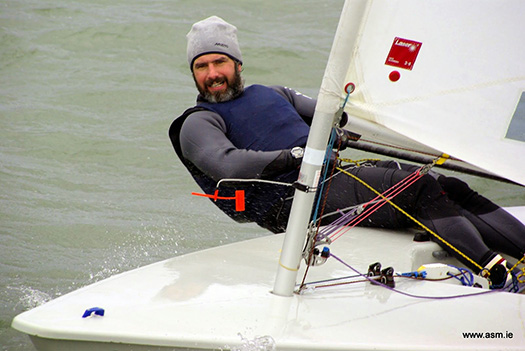


Squib Keelboat Class Agrees To Modernise
#squib – There are developments afoot for The Squib keelboat following a recent ballot of boat owning members. The Squib Class voted overwhelmingly in favour of rules change to improve and modernise the design.
The class will stage its 2015 British and Irish Championships in Howth, County Dublin this Summer. Over 70 boats are expected to compete.
Final proposals are now being agreed with the RYA prior to work commencing on new moulds and a prototype, which we hope to complete in time for it to be sailing at the Class National Championships at Howth.
The improvements are intended to enhance the Class without outdating any existing boats. There are a number of construction and fitting improvements including a self draining cockpit.
The low maintenance construction system will comply with the requirements of Recreational Craft Directive (RCD). The hull form and sail plan will remain unchanged but the Squib will have a 'fresh, more modern feel' and benefit from a quality construction method.
The self draining cockpit is a major safety improvement and will allow Squibs to both sail and be left on moorings without the need for bailing out, thus making the Squib more user friendly for racing, cruising, and for use by sailing schools.
The Squib has been in existence for more than 46 years and continues to be a successful small keelboat for racing and coastal day cruising. 65 plus boats competed at the 2014 National Championship and 31 boats started on the line at last year's Cowes Week. The Squib Class was overall Class winner at Cowes Week 2014.
More on the UK site here. For more on Irish Squib sailing read WMN Nixon's blog
RS400 Adds to Kinsale Yacht Club Frostbite Series
#kinsaleyachtclub – Day two of the ASM Kinsale Yacht Club frostbite series saw typical frostbite weather, cold, bright, sunny with near perfect sailing conditions. The wind was 10–knots gusting to 12.5 from NNW. Each of the 5 fleets got 3 great races in shifting conditions which made it a great test for all competitors. Each of the fleets had close racing, especially the ever popular Squib Fleet.
Race Officer & KYC Sailing Secretary, John Stallard was delighted to see the arrival this week of the RS400 fleet which has added greatly to competition and made for a beautiful spectacle in the bright sunshine on Kinsale inner harbour.
Maeve Leonard from RCYC appeared out today in the Laser Radial fleet and produced 3 bullets to dispense with all opposition. Her club mate Luke McGrath achieved the same result in the Laser 4.7 fleet.
The Full rig fleet was smaller today and the field is led by Monkstown's Ronan Kenneally followed by Club mate Paul O'Sullivan.
In the Squib fleet KYC's Colm Dunne and Rob Gill have an astonishing result of 6 bullets after 6 races, they are hotly pursued by KYC's Commodore Finny O'Regan and his son Colm.
Sail number 1260 takes the lead in the fledgling RS400 fleet.
Racing continues next week....

Squibs on a Run
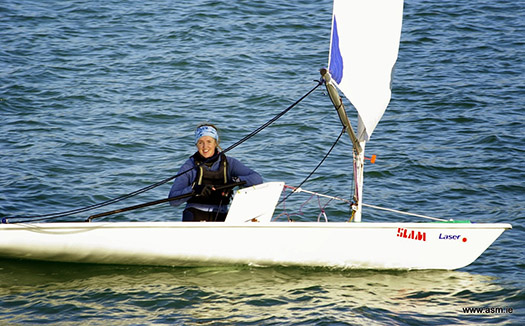
Maeve Leonard of RCYC looking happy with 3 wins from 3 races
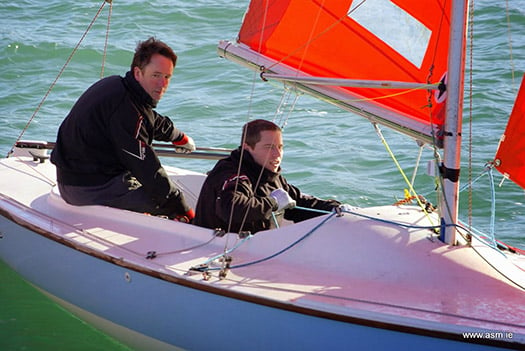
KYC's Colm Dunne & Rob Gill in their Squib Allegro, in the lead with 6 bullets after 6 races...
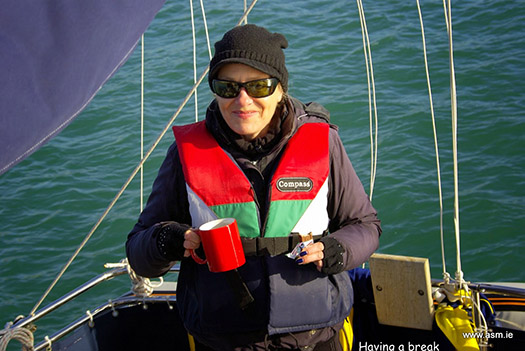
Committee Boat stalwart Sue Horgan

Lasers heading to Castlepark
All photos courtesy of Seamus McLaverty of ASM Marine
2015 Sailing Calendar Includes Two Bicentenaries & Ireland's Biggest Regatta At Dun Laoghaire
Irishsailing – After the remarkable across-the-board success of the 2014 Irish sailing season, 2015 will have to be very special indeed to be remembered with such enthusiasm. But it's a special year in any case, as two major sailing Bicentenaries – one in the Irish Sea, the other in the Solent – will have added and poignant meaning, as the Centenaries a hundred years ago could not be celebrated because of the First World War.
As for Irish sailing generally, life moves on, there are new sailors on the water, successful young sailors are graduating to the next stage of their rapidly developing careers, and established stars continue to plan fresh campaigns, for sailing is indeed a sport for life.
Then too, new fixtures successfully introduced in 2014 will require nurturing, tuning and encouragement if they are to fulfil their potential in the coming year, while at the same time there's always extra effort needed to give proper support to established fixtures, which have to live with the reality that they might wilt through being taken for granted. Both new and longer-established boat classes will need continued enthusiastic involvement, and our well-loved classics and traditional craft must be cherished and sailed, for lack of use is the real enemy of boats, whether old or new.
As for the major administrative initiatives introduced in 2014, they will need constant monitoring, but deserve full support from the sailing and boating community at large, for it was in response to a grass-roots initiative that the radical and very necessary reforms of the Irish Sailing Association were undertaken. Those appointed to undertake the root-and-branch reform of the national authority have done so with commendable dispatch, so it is now the duty of the rest of us to support their continuing efforts. And we can best do that by enjoying our boats and our sailing and time afloat in its myriad of interests, while encouraging others to do the same. W M Nixon outlines on what the coming year may bring.
One thing at least is certain for the coming season afloat during 2015 in most of Europe. It will not mark any significant sailing Centenaries. Instead, we are immersed in four years of remembering the Great War of 1914-1918 a hundred years on, with all the added twists of that period's longer historical narrative in Ireland. In such a context, it may seem frivolous to point out that sports like yachting have no great Centenaries to mark at all in 2015. But this minor off-screen fact is a reminder of the all-involving horror and obscenity of total warfare on an industrial scale. It obliterated anything like normal life.
Yet as recreational sailing had been going on in some sort of organised form for hundreds of years – albeit in a fairly rudimentary way in its earliest years in the 16th Century – there may well have been several important dates to be marked during the time of the Great War itself, but they were allowed to pass as there was no sport afloat, while civilian life ashore was very subdued.
And in Ireland, with the Troubles persisting for four years after the end of the Great War until 1922, the Bicentenary of the Royal Cork Yacht Club in 1920 was to be a muted affair – the official History of the Royal Cork Yacht Club (published 2005) tells us: "Plans for a special dinner to celebrate the club's bicentenary in 1920 had to be cancelled, probably because of the disturbed conditions in the country"
So the idea of celebrating the Centenary of the Royal Yacht Squadron in Cowes in 1915 at the height of the international war - other than in a rather solemn shorebound way - would have been unthinkable. But that in turn fuels the celebrations when the peacefulgood times roll again. Thus the Royal Cork Yacht Club, having been unable to celebrate its Bicentenary in 1920, went on to have a fabulous two-year Quarter Millennium celebration in 1969-70. And as the RYS couldn't have a proper party in 1915, there's no doubt that the up-coming Bicentenary in 2015 will be the nucleus of international sailing's megafest-of-the-year.
There are of course several clubs which pre-dated the Squadron when it was founded in 1815. And there are many whose members outshine the small membership of the RYS in the breadth and energy of their sailing. But for 2015, let's just acknowledge that the prestigious Squadron has been at the heart of sailing history for a very long time, while their clubhouse's location right on the Solent at Cowes is so central that when any great Solent-related events are under way, the Squadron is in the middle of the story.
Thus it was on the Squadron lawn that in July that the Irish team celebrated their epic Commodore's Cup victory at the end of July 2014. And it will be towards the Squadron and its Bicentenary that the fleet will be racing in 2015's west-east Transatlantic Race. And then it will be the firing of the cannons from the historic Squadron battery which will signal the start of the 46th Fastnet Race on 16th August 2015.
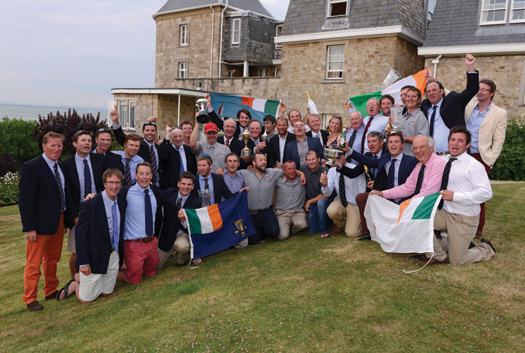
Party time at the Royal Yacht Squadron – the Irish team and their management gather to celebrate victory in the Commodore's Cup at the Squadron Castle in Cowes on August 1st 2014
There'll be many Irish boats involved, and the best-placed of them at the finish will be the winner of the Gull Salver, currently held by Martin Breen's Reflex 38 Lynx from Galway Bay SC, which was skippered to success by Aodhan FitzGerald in 2013's race. It's a coveted trophy, instituted to honour the memory of Harry Donegan of Cork and his famous cutter Gull, which was one of seven boats which inaugurated the Fastnet Race in 1925, and placed third. Since then, Irish Fastneteers have frequently been in the great race's top places, and best of all was in 2007 when Ger O'Rourke's Cookson 50 Chieftain out of Kilrush, sailing under the burgee of the revived Royal Western of Ireland YC, came sweeping in to the finish line at Plymouth to win the Fastnet Race
overall.
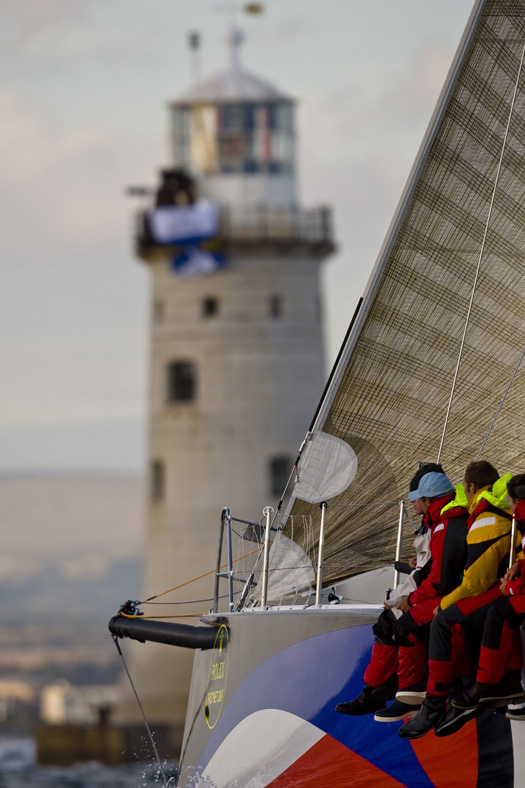
One of the greatest moments in Irish sailing history – Ger O'Rourke's Chieftain sweeps towards the finish line to become the overall winner of the Rolex Fastnet Race 2007. Photo: Rolex
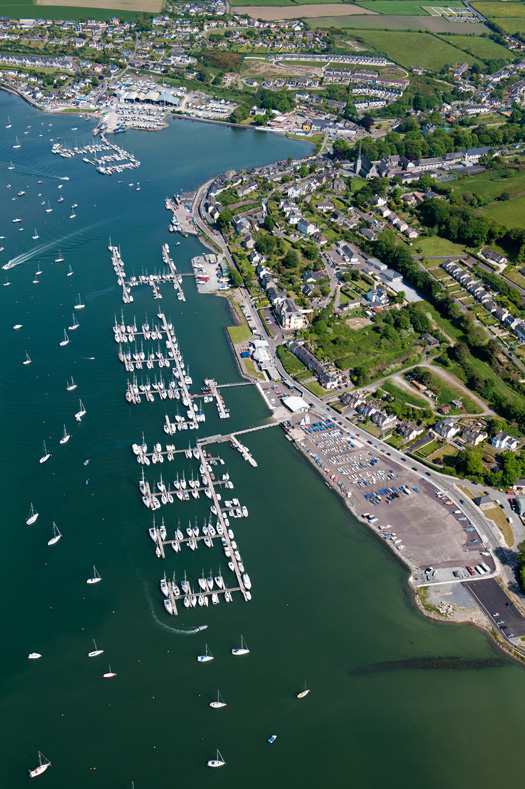
Just the spot for a great Tricentenary celebration - the very complete sailing facilities provided jointly by the Royal Cork Yacht Club and Crosshaven will become a world focus in 2020 with the Club's 300th anniversary. Photo: Bob Bateman
The realisation that 2015 sees this significant RYS Bicentenary is a timely reminder that the Royal Cork's Tricentenary is only five years down the line. They're five years which will be gone in a flash, and already behind-the-scenes moves are afoot to ensure that the national sailing programme will properly facilitate the extraordinary anniversary being celebrated in Crosshaven in 2020.
But meanwhile other Irish sailing centres have their own regular programmes to operate in the intervening four years, and in terms of numbers and scale there's no doubt the top event in Ireland in 2015 will be the biennial Volvo Dun Laoghaire Regatta from 9th to 12th July.
Anyone – and there were many - who took part in this unique "suburban sailfest" in 2013 will know that the VDLR has come of age. It's an event which is comfortable with itself while at the same time being always in development and evolution mode. Each staging of this remarkable Dublin Bay happening sees lessons being learnt and implemented even while the multi-class racing is under way on several courses. And in the two year gap before the next staging, the experience gained is closely analysed and the programme refined to further improve the sport in every area.
You get some idea of the sheer depth of racing experience in Dun Laoghaire by noting that the Chairman of the 2015 Committee is Tim Goodbody, with Martin Byrne as Vice Chairman while the Race Director is Con Murphy. And those three sailing megastars are just the peak of a mountain of race administration experience which is being drawn in from all over Ireland to ensure that the fleet of 400-plus boats gets the best sport possible.
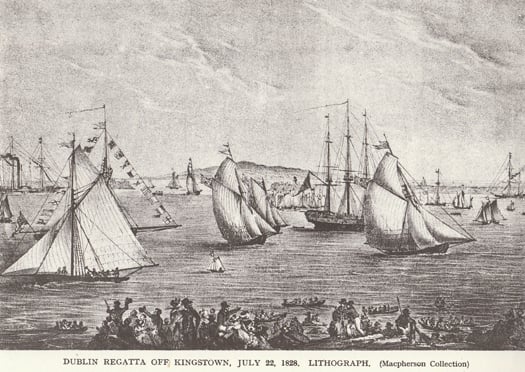
The first regatta in 1828 at the new harbour at Dun Laoghaire, which will be the setting for Ireland's biggest event in 2015, the Volvo Dun Laoghaire Regatta from 9th to 12th July.
While there'll be keenly participating boats from all over Ireland as well as Scotland, England and Wales, the setup of Dublin Bay being right on the city's doorstep means that it's the locals who would pose an administrative problem for a less experienced team. As the dates for the VDLR approached in 2013, the weather forecast steadily improved, and thanks to the Regatta's "extra long weekend" format, the sudden arrival of summer meant that a host of boats from the greater Dublin area came in as last minute entries, their owners and crews managing to scrape the extra day-and-a-half needed off work. It's a scenario which would put an overstretched administration off course, but the VDLR team took it calmly in their stride, and the result was a successful summer festival of sunlit sails and great sport, with maybe two thousand taking part.
This year there's a more structured cross-channel involvement, as the venerable Royal Dee YC in Cheshire has leapt to life to celebrate its Bicentenary. Founded as the Dee Yacht Club in 1815 with the end of the Napoleonic Wars, it didn't get the Royal seal until 1947, but nevertheless claims to be older than the RYS. With growing fleets in North Wales and the Mersey, it has put together a Bicentennial Royal Dee Irish Sea Offshore Championship linked closely to ISORA, which will bring the fleet across to Ireland to take in four offshore day races sailed as part of VDLR 2015.
Irish National Championships which will be part of the VDLR 2015 programme include the J/109s, the RS Elites, the Beneteau First 21s, and the Wayfarers, while the Leinster GP 14 Championship is also included as an integral part of the Regatta.
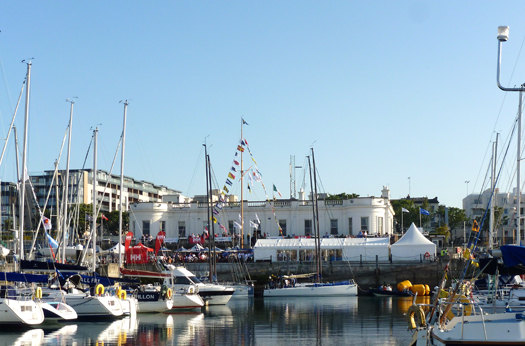
Party time in Dun Laoghaire – the Royal Irish YC during VDLR 2013. Photo: W M Nixon
As for Ireland's classic clinker-built vintage classes, one of the pleasantest surprises in VDLR 2013 was the large turnout of Mermaids, which had superb racing on the course area in the northwest corner of Dublin Bay. Despite having been born as the Dublin Bay SC Mermaid in 1932, this class of 17ft super-dinghies is no longer included in the regular DBSC programme owing to shortage of numbers for weekly turnouts. But it seems that as far as the VDLR is concerned, the Mermaid is now an event boat, and the fleets still thriving at other centres, together with some of the dormant Dublin Bay craft, bestirred themselves for the four days to enjoy good sailing for more than three dozen boats, something which is highly likely to be repeated in 2015.
The even more venerable Water Wags, founded 1887 with the current boats dating from 1903, continue to thrive in Dun Laoghaire, and the word is they expect to have at least twenty boats in action, while another wooden classic, the Mylne-designed 25ft Glen keelboat, is 50 years and more in Dun Laoghaire, and looks forward to having at least twelve boats racing in 2015.
All these specialized and historic classes are in addition to the numerous cruiser-racers which continue to be the backbone of Dublin Bay sailing. And while many of them will see the VDLR 2015 as a highlight of the year, in turning to consider the overall national programme, we find a sport which is shaking off economic recession to get on with an extraordinary plethora of local, national and international sailing events.
The problem is that most events of significance hope to locate themselves in the peak sailing period from late May to early September, so clashes are almost inevitable, and if you're interested in several different kinds of sailing, the overall choices can be bewildering in their complexity and logistical challenges.
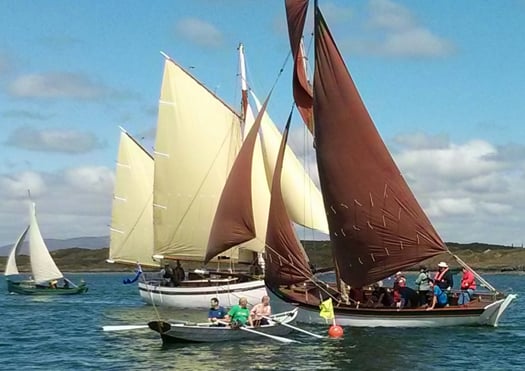
The Baltimore Wooden Boat Festival attracts an eclectic fleet – included here are a Shannon Gandelow, a West Cork Mackerel Yawl, the ketch Sile a Do, and an Heir Island Lobster Yawl (left).
For instance, the variety of events now available for the traditional and classic boats – usually but not necessarily under the Old Gaffer umbrella – would keep anyone busy for most of the summer. It starts with the Baltimore Wooden Boat & Seafood Festival from Friday 22nd May to Sunday 24th May, which you'd think very early
in the season for someone faced with fitting out an old wooden boat in Ireland's climate, but somehow they do it.
Then on the East Coast for the early summer Bank Holiday Weekend from May 29th to June 2nd, there's the Old Gaffer gathering in Dublin Bay at Poolbeg Y&BC with the annual race for the Leinster Trophy in the bay on Saturday May 30th, the event then morphs into the Dublin Port Riverfest in the Liffey on Sunday May 31st, and finally it all concludes with the race for the Asgard Trophy back in the bay on Monday June 1st.
The annual Lambay Race at Howth, a regular fixture since 1904, has seen its course becoming increasingly complex in modern times in order to satisfy the desire of modern racers for competition on every possible point of sailing. But in 2014, to celebrate the Centenary of the Lynch family's Echo, the venerable Howth Seventeens were sent on the traditional course north from Howth Harbour through the sound inside Ireland's Eye, then on round Lambay leaving it to port, and then back south inside Ireland's Eye again to the finish at Howth pierheads.
This was such an attractive proposition for Old Gaffers and Seventeens alike that on the day an extra Classics Division was added to cater for ancient craft, and it hit the spot. This option will be offered again for 2015's Lambay Race (it's on Saturday June 6th), and the word is that Dickie Gomes's 1912-built 36ft yawl Ainmara will be coming down from Strangford Lough to defend her title after 94 years. 94 years? Yes indeed - she won the Lambay Race in spectacular style in 1921 when still under the ownership of her designer-builder John B Kearney.
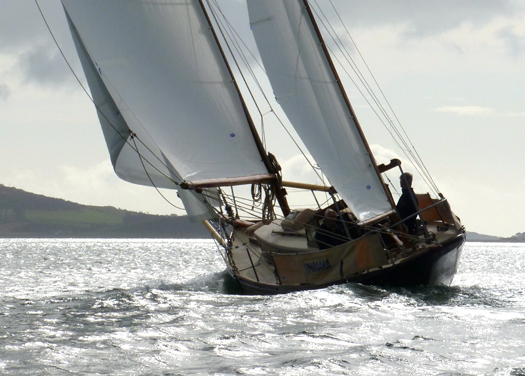
After 94 years, Dickie Gomes's 36ft 1912-built yawl Ainmara (seen here on her home waters of Strangford Lough) hopes to return to defend the title in Howth's Lambay Race, which Ainmara won in 1921 while still in the ownership of her designer-builder John B Kearney. Photo: W M Nixon
The Old Gaffers attention then swings north as the Tall Ships are coming to Belfast from Thursday 2nd July to Sunday 5th July. This is going to be a serious biggie with those ships already signed up including a significant turnout of Class A vessels, which are square riggers and others of more than 40 metres in length. Belfast Lough lends itself particularly well to the Parade of Sail which follows a Tall Ships gathering, and in 2009 when they were last in the port they put in in a virtuoso display with the Dutch ship Europa in particular going to the trouble of getting herself over towards Whiteabbey in the northwest corner of the lough to allow her time get every stitch of sail set before proceeding seawards down-lough in colossal style, a much more impressive display than we've become accustomed to in Dublin, where the shape of Dublin Bay is such that it doesn't really provide the space for square riggers to set all cloth before getting out to sea.
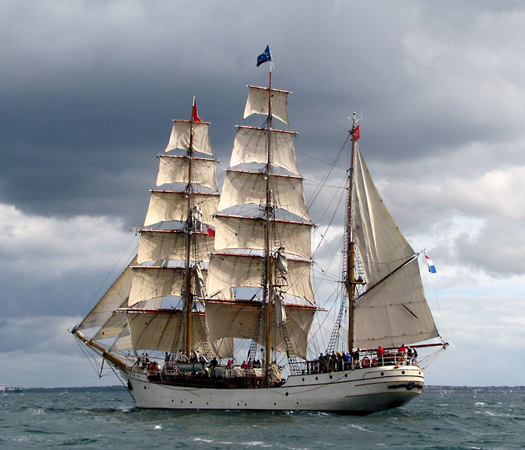
The Tall Ship Europa shows how it should be done in Belfast Lough in 2009, taking time out to set full sail before she starts to gather power to make the proper input into the Parade of Sail.
Like Dublin, Belfast has shown it can be hospitable to Old Gaffers, and it was a very welcoming main port during the OGA Golden Jubilee Cruise-in-Company in 2013, so for 2015 the OGA National President Sean Walsh hopes to up the ante by persuading his members from all round the Irish Sea to gather in Belfast, and to add spice to the mix, he hopes to persuade the Howth 17s to put in an appearance as well, to sail with local one designs like the 1903 Belfast Lough Waverley Class, which have been experiencing a revival in recent years.

Old Gaffers in Belfast for their Golden Jubilee in 2013. The Irish Sea classic and traditional fleet will return to the same venue for the Tall Ships gathering in July 2015. Photo: W M Nixon
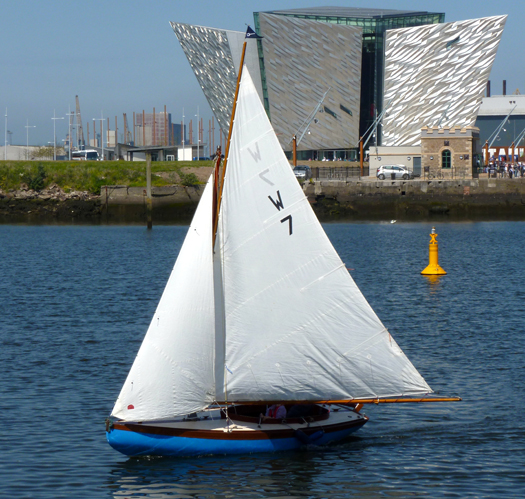
The Belfast Lough Waverley Class Lilias (built 1903) sailing at the Titanic Centre in Belfast. In 2015, the Waverleys will be joined by some of the 117-year-old Howth 17s to participate in the visit of the Tall Ships. Photo: W M Nixon
The Seventeens have made long treks as a class before – in 1998, five of them were road-trailed to Carrickfergus to mark the class's Centenary, with the first five boats built by Hilditch of Carrickfergus. So though they'd trailed there, they then sailed the 90 miles back to Howth, just as the first boats had done a hundred years earlier. Then in July 2003, fifteen of the Seventeens took part in the Glandore Classics Regatta thanks to a brilliantly organised exercise in logistics using a flotilla of low loaders which could take three boats apiece.
For all of Ireland's classic and traditional boats in 2015, and an international fleet too, Glandore is very much up on the radar again, as a special effort is being made by a GHYC team led by Donal Lynch to encourage increased numbers in the CH Marine Glandore Classic Regatta from Saturday July 18th through Friday July 24th. It's a date which certainly allows Old Gaffers plenty of time to get down from Belfast, indeed some may even consider the option of making the voyage northabout to take in a round Ireland cruise while they're at it. And as that great magnet of the Irish Sea classic and traditional scene, the Peel Traditional Boat Weekend, isn't until Friday 31st July to Sunday 2nd August, it's just about possible to factor that in as well.
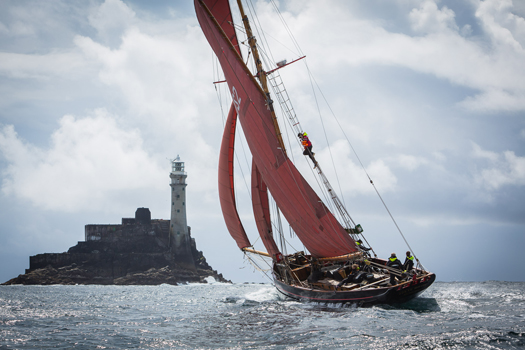
Everything happening at once – the famous Pilot Cutter Jolie Brise was the star of the Glandore Classics in 2013, and as it was her own Centenary she celebrated by sailing round the Fastnet Rock – she has been a successful Fastnet Race participant several times. Photo: Brian Carlin
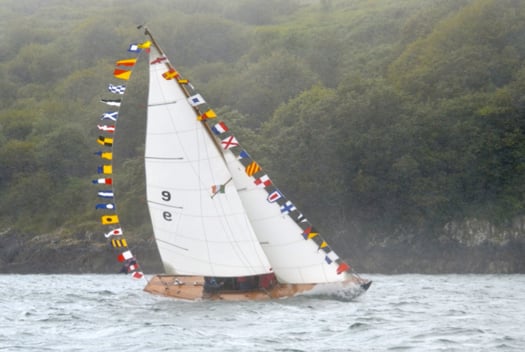
The Glandore Classics attracts an international fleet, and 2013's regatta included a class of Fife One Designs from the Menai Straits, all of them keen to party and showing it. 2015's Glandore Classics is from July 18th to 24th. Photo: Cormac O'Carroll
All this is already happening for the oldies with August barely under way, yet for modern cruiser-racers the potential programme for any keenly-sailed Irish boat is equally complex, attractive and challenging. The season starts as usual with the Scottish Series from Friday 23rd May to Monday 26th May – there'll probably still be snow on the mountains of Arran. They've gone back to their roots by starting with a feeder race from Gourock to the main regatta centre at Tarbert on Loch Fyne. "Going back to the roots" is something of a theme for this year's staging of the Clyde Cruising Club's main racing event, as this is the 40th Scottish Series. Come to think of it, there are so many important 40th anniversaries happening in sailing these days that we have the admit that the decade which brought us the full horror of wide lapels and flared trousers also contributed some lasting elements of the international sailing scene, indeed it could be said that the modern era in sailing really began about forty years ago.
Back in Ireland, the ISORA programme will be well under way by June, while the Lambay Race on June 6th can be looked at with more interest by several boats, as the biennial National YC Dun Laoghaire to Dingle Race doesn't start until Friday June 12th . Last time round, there was a total fixtures clash between the two events, but in times before that hyper-keen sailors such as the Tyrrells of Arklow with Aquelina have been able to fit in both, indeed one year they did it so well they won both too, and were rightly acclaimed as the Afloat "Sailors of the Month" for their success.
For 2015, defending champion in the Dingle Race is Brian O'Sullivan of Tralee with the veteran Oyster 37 Amazing Grace, which came good in the end in 2013 with a new breeze which knocked pending leader Antix (Anthony O'Leary) off the winning perch. But with the 2015 Dingle Race acting as a useful if rather indirect feeder for the Covestone Asset Management Sovereigns Cup in Kinsale from June 24th to 28th, there could be all sorts of sharp boats lining up to take the prize, for the Sovereigns Cup 2015 includes the all-singing all-dancing ICRA Nats 2015.

The welcoming port – Kinsale is one of Ireland's most popular destinations, and in 2015 its hosts the combined Sovereigns /ICRA Nationals from June 24th to 28th.

Perfect sailing – racing in the Sovereigns at Kinsale in June 2013. Photo: Bob Bateman
Yet the timing of the combined Sovereigns/ICRA Nats is such that there's still plenty of time and space to get back to the Irish Sea for the Volvo Dun Laoghaire Regatta 2015 from July 9th to 12th, a reminder that much of the cruiser-racer programme for 2015 is in a neatly balanced and user-friendly timescale for everyone except perhaps those who wish to do either the entire ISORA or SCORA programme as well, so the problem mostly is going to be getting time off work.
And for the hyper-keen cruiser-racers, particularly those whose boats are small enough to be conveniently trailerable, further temptation looms in 2015 with the WIORA Championship at Galway Bay Sailing Club from July 22nd to 25th. For the fleets in the Shannon, on Tralee Bay, and in Clew Bay, it's a bit more than a day's sail away, but they'll be there to challenge Liam Byrne of the home club who won it in 2014 with his Corby 25 Tribal at Mayo SC in Clew Bay, while some top boats from more distant centres are expecting to trail to Galway Bay to spice up the competition.
By this stage of the season a more relaxed pace might be welcome, but the lively turnout of 80 boats in 2014 for the new-style four day Cork Dry Gin Calves Week out of Schull in early August (Tuesday 4th to Friday 7th August in 2015) suggests that for racing sailors, the best relaxation is more racing, but in a holiday setting. And yes, it has been noted that a true West Corkian sailing nut could indeed do all of Calves Week 2015, and still be on the Squadron line for the start of the Fasnet Race nine days later.
For dinghies in 2015, the big story is the debut of the newest version of the National 18, and just how popular will the Bray-bult foiling Moths become, while established classes will frame their programmes to accommodate sailors whose time is limited, also having to fit in with a national scene where the number of Race Officers with the necessary skills is inevitably a finite amount.
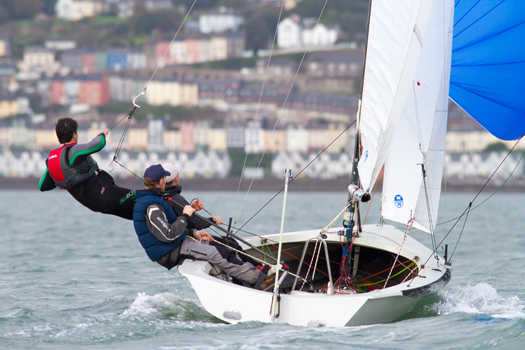
The big stories in Irish dinghy racing in 2015 will be the arrival of the new National 18s at Crosshaven, and the revival of Dinghy Week there in late August. Here, in the Autumn of 2013, To Dwyer and Nin O'Leary test sail the prototype of the new 18 on Cork Harbour. Photo: Bob Bateman
The new Third Generation (or maybe it's fourth or fifth generation) National 18 may have been designed in England by Phil Morrison, and is being built there too. But it was the very active Crosshaven fleet with the Royal Cork Yacht Club which led the charge towards a new boat, and when it came to stepping up to the plate to pay twelve substantial new boat deposits to move it all along after the prototype had been rigorously tested in Cork harbour last Autumn, it was the Crosshaven fleet that provided eight out of those twelve cheques.
So it's entirely appropriate that in August 2015, the dinghy focus will swing big time towards Crosshaven and a short form "Dinghy Week" from August 21st to 23rd. The old style Irish Dinghy Weeks – the last one was in 1970 – became victims of their own success, they just got too large. But the different classes became over-optimistic about their continuing individual growth prospects. Then the pendulum swung too far the other way, and dinghy classes were alone and their events shrinking. But a resurgence of club and championship dinghy sailing in Crosshaven during 2014, and a growing realization that over-reliance on single-handed dinghy classes does not necessarily produce a socially-adjusted national squad of junior sailors, resulted in some clear and creative thinking about developing two-handed boats, and reviving some old classes such as the Mirrors.
The form of this new Dinghy Week is still in the melting pot, but at least eight classes have responded with enthusiasm. Meanwhile, the National 18s in Crosshaven will be such a focus of interest during 2015 with the first of the new boats making their debut that we'll have a season-long dinghy narrative developing on Cork Harbour, and the revived Dinghy Week will be just part of it.
As for inshore keelboats, the big one in terms of number is the combined British and Irish Championship Squib Championship at Howth from 27th June to 3rd July. The handy little Squibs are something of an oddity, as they serve so well as a cherished local class in so many Irish sailing centres that many owners see them as that, and nothing more – handy little club sailors to be raced on home waters a couple of times a week.
This means that when a major regional or national event is held, the number taking part will often only be a fraction of the total Irish Squib fleet. But for those who do make the trek, the competition is fierce and the racing great – in Howth, the high point was in 1996, when this "Nationals" event attracted a fleet of exactly a hundred boats, and on one never-to-be-forgotten morning, there they were, every last one of them on the starting line.

A hundred Squibs all in a row at Howth on Tuesday July 25th 1996. Photo: Mandy Murnane
The most recent Squib event of national stature was the Freshwater Keelboat Regatta at Dromineer on Lough Derg on the weekend of October 18th-19th, and the battle for the top places was between the Kinsale and Belfast Lough fleets, with James Matthews and Rob Jacob of Kinsale rounding out their year in style with a good win.
But with the Squibs in England undergoing a revival – they were the second-biggest One Design fleet in Cowes Week 2014, bested only by the legendary XODs – there's no doubt there's a strong challenge coming across channel, and any Irish boat getting into the top ten will be doing well.
As for that annual Autumn Freshwater Keelboat Regatta at Dromineer, while it may have been much hampered by the spinoff from some ferocious weather out in the Atlantic with frustration for some of the sixty boats hoping to take part, it's an event of enormous potential, and the many who wish it well and have enjoyed it in the past will be ready and willing to do their part to make 2015's regatta a success.

The Squibs enjoying a lull in the strong winds during the Lough Derg Freshwater Regatta 2014. Overall winner was Mucky Duck (no 51, James Matthews & Rob Jacob, Kinsale YC). Photo: Gareth Craig
All these specialised and localized events planned for 2015 will be the continuing background music to the usual events of national sailing focus, everything from the selection of the Irish team for the Student Yachting Worlds to the Helmsmans Championships to the steady increase in pace while 2015 develops as the pre-Olympic year. As the year rolls along, other stories will develop too. So perhaps it's appropriate that we exit this review as we entered it. Just pause to remember now and again that, a hundred years ago, you simply couldn't have gone freely afloat like this for sport and recreation at all.
But we can't close on such a solemn note. Seasoned Solent sailors may have noted our header photo from Guido Cantini at the Panerai Classics Regatta was looking just slightly odd, for some reason difficult to pin down. Well, as it happens, the photo was sent to us back in September just as we were contemplating the excellent cleanup up done by Jason Hurley of Jason Hurley Design on the Mercedes-sponsored billboard photo of Howth 17s on the end wall of Howth Yacht Club. As with many photos taken over the RYS starting cannons, the Cantini pic included an obtrusive part of the Fawley Oil Refinery across on what Isle of Wight people call "the north island". Though Fawley has been there for yonks, it still has the look of a temporary structure. So we got Jason to treat as just that. But here for your edification is the true picture. You could get a taste for this sort of thing. What about brushing out Whitegate, lads? And as for Milford Haven.........
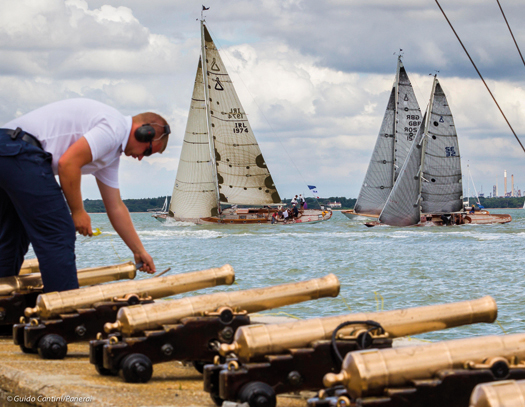
The unvarnished truth. In real life, the view from the RYS battery at Cowes can be slightly marred by the clutter of Fawley Refinery across the Solent on "the north island". Photo: Guido Cantini/Panerai
Read also: 2015 Irish Sailing Fixtures List (provisional)
Lough Derg Drubbing For Some, But Dragons & Squibs Rise Above It
#loughderg – Lough Derg's annual Keelboat Freshwater Regatta in October is meant to round out the season with some gentle lake sailing for salty folk in big boats. But 2014's event last weekend was just too near a ferociously active bad weather system which had lows sometimes down to the 950s spinning around each other out in the Atlantic close to Ireland's West Coast. Thus although it was possible to get in the racing in the CH Marine Autumn Series down at Crosshaven, while the MSL Park Motors Autumn League at Howth concluded in balmy if breezy conditions across on the east coast, over to the west on Lough Derg they were lashed by the tails of two storms, and two classes failed to get any racing at all. But if you happened to be with the stately Dragons or the perky Squibs, then there was some great sport which has W M Nixon reflecting on the way our keelboat classes are developing.
Of all Ireland's lakes, it is Lough Derg which most truly merits the description of "Inland Sea'. Lough Neagh may have greater area, but in the final analysis it's only an oddly characterless shallow basin which happens to be filled with water. Lough Erne is marvellous, but too convoluted. Lough Ree has the area and the intricate coastline, but lacks the scenery. And while Lough Corrib is right up there in the beauty stakes, it's isolated from the rest of the world.
But Lough Derg – now there really is a proper inland sea. It has splendid scenery, and historic little ports with ancient quaysides all round its complex coastline, while beside them you'll find modern marinas which host an astonishing variety and number of boats, including some quite substantial sailing cruisers.
Not only is it a splendid place unto itself, but Lough Derg is part of the greater world. From it, you can undertake inland voyages to every part of Ireland, yet it takes only a day to access the sea and the oceans beyond. It's the sort of place where boating and sailing ambitions can seem endless, so it's not surprising that in recent years the Autumn keelboat regatta has become a trendy annual fixture.
Last weekend, sixty boats from four classes headed Dromineer way, to a hospitable bay and village where Lough Derg YC has been established since 1835. Keelboat racing is nothing new on Lough Derg, but boat numbers at this level is something new, and the logistics of getting the visitors launched, and organising racing on two courses when the weather was being massively unco-operative, caused something of an overload on the club system.
As well, being slightly later in October than is usual, some key members of LDYC's small core of voluntary workers afloat and ashore were already out of the country on their usual mid-Autumn breaks. So although it would have been manageable if the weather had been clement, with the main part of the racing planned for mid-lake there simply weren't the service boats and personnel available to make a sudden shift of some of the racing to a second inshore course in Dromineer Bay.
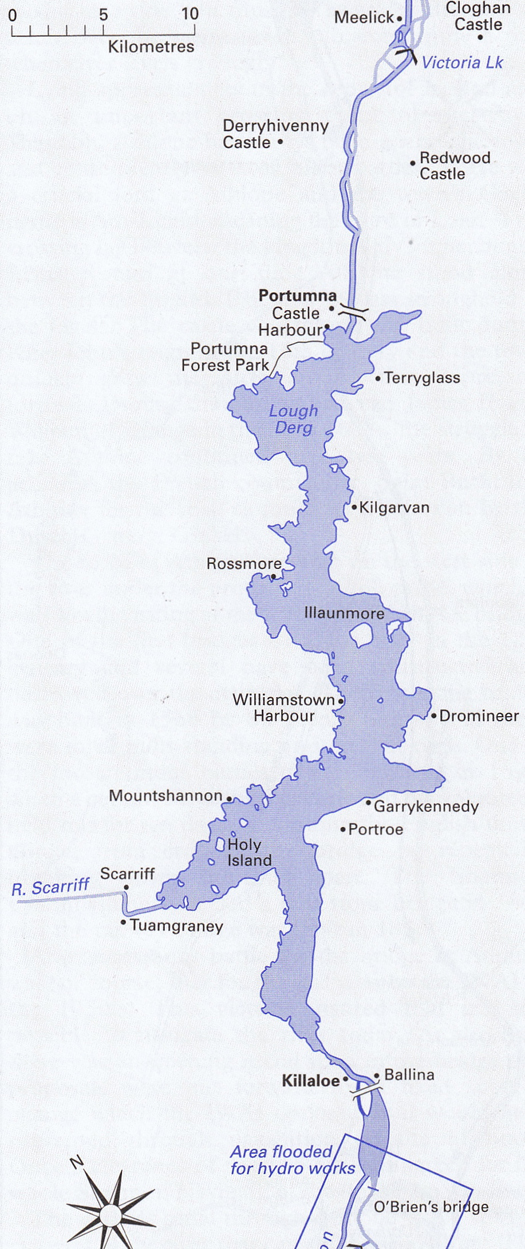
Lough Derg isn't just a lake – it's a proper inland sea with connections to the wide world.
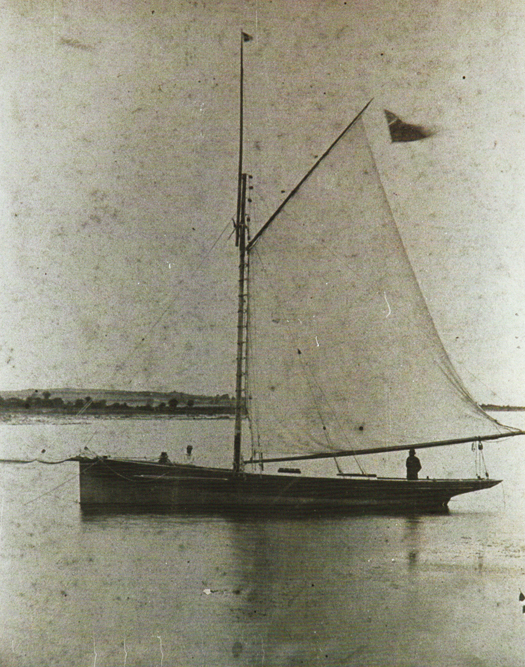
There's nothing new about keelboats on Lough Derg. This is the 7-ton cutter Tessa (Trahern Holmes, LDYC) on the lake in 1884......
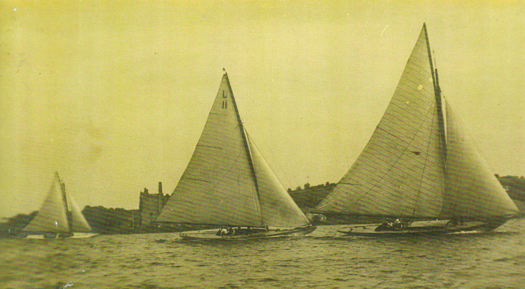
....and this is the keelboat class at Dromineer in the late 1920s. The Bermuda rigged sail number L11 is a former Olympic 6 Metre from Finland
Happily for the Dragons racing in their well-established challenge for the Jack Craig Cup, the trophy which started the whole Dromineer Autumn Keelboat event, their racing was planned for three days. In the end, they only managed the required mid-lake racing on the Friday, but it gave great sport.
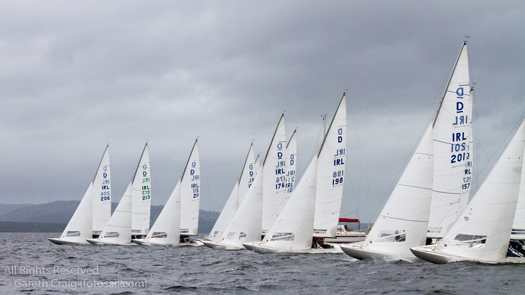 The Dragons start on the Friday. It was the introduction of the Jack Craig Cup for the International Dragons which inaugurated the Lough Derg Keelboat Regatta. The overall winner was to be Phantom (Neil Hegarty, RStGYC, no 176) Photo: Gareth Craig/fotosail
The Dragons start on the Friday. It was the introduction of the Jack Craig Cup for the International Dragons which inaugurated the Lough Derg Keelboat Regatta. The overall winner was to be Phantom (Neil Hegarty, RStGYC, no 176) Photo: Gareth Craig/fotosail
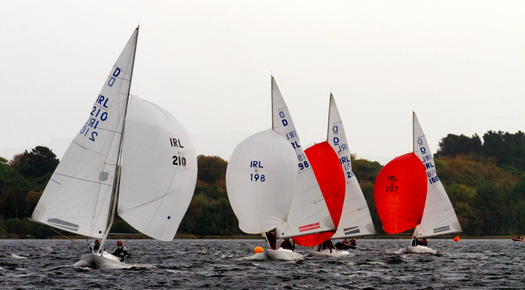
Diva (Richard Goodbody) holds the lead downwind from Dublin Bay (Gary Treacy), Little Fella (Cameron Good) and Mar J (Adrian Bendon) Photo Gareth Craig/fotosail
 When the going was good for the Dragons at Dromineer, it was very good. Gary Treacy's Dublin Bay from Dun Laoghaire and Adrian Bendon's Mar J from Kinsale neck and neck on the run, with Lough Derg YC's clubhouse and harbour on the shoreline beyond. Photo: Gareth Craig/fotosail
When the going was good for the Dragons at Dromineer, it was very good. Gary Treacy's Dublin Bay from Dun Laoghaire and Adrian Bendon's Mar J from Kinsale neck and neck on the run, with Lough Derg YC's clubhouse and harbour on the shoreline beyond. Photo: Gareth Craig/fotosail

Gary Treacy's Dublin Bay settles into the groove upwind. Photo: Gareth Craig /fotosail

Richard Goodbody's Diva showing the form which won second overall. Photo: Gareth Craig/fotosail
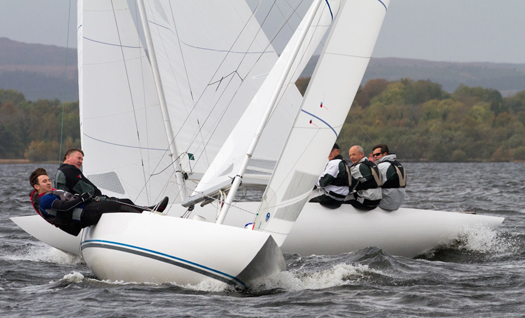
Martin Byrne's Jaguar at the finish on starboard. A former Edinburgh Cup winner, Jaguar placed third on Lough Derg. Photo: Gareth Craig/fotosail
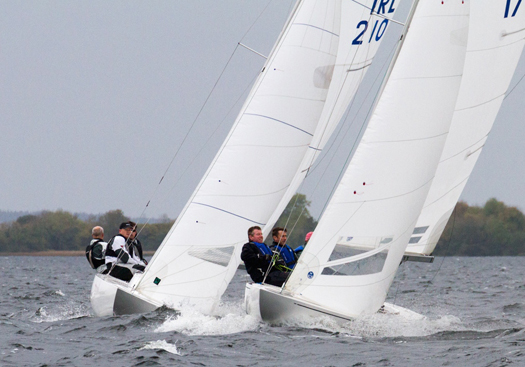
The Lough Derg 2014 Dragon Champions – Neil Hegarty's Phantom (right) won from Richard Goodbody's Diva (left). Photo: Gareth Craig/fotosail
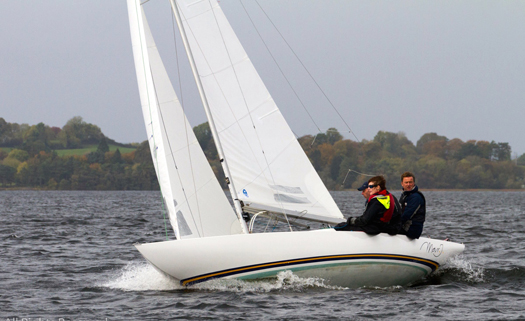 Autumn sailing at its best – Adrian Bendon's Mar J from Kinsale closes in on the finish and tenth place overall at Dromineer. Photo: Gareth Craig/fotosail
Autumn sailing at its best – Adrian Bendon's Mar J from Kinsale closes in on the finish and tenth place overall at Dromineer. Photo: Gareth Craig/fotosail
However, for the SB20s and the Flying Fifteens, trying to race the same waters on Saturday proved a non-event, and again on Sunday too. All of which made it even more galling that the Squibs, the biggest fleet of all, had requested their own simple windward-leeward course set further into Dromineer Bay on the Saturday. As long as the wind stayed in the south, the Squibs were able to race on into Saturday afternoon until, with a slight veering and further freshening of the already strong wind, all options were off.
Then on the Sunday with the wind firmly in the southwest and strong, only the Squibs had racing with one contest out on the lake, and another – with very short legs – in the inner bay. With hindsight, it seems reasonable to think that room might have been found in the bay for the two other classes of smaller boats, though admittedly the SB20s at full cry do need quite a bit of space. But that would have needed some very slick manoeuvres by more supporting RIBs, committee boats and personnel than were available.
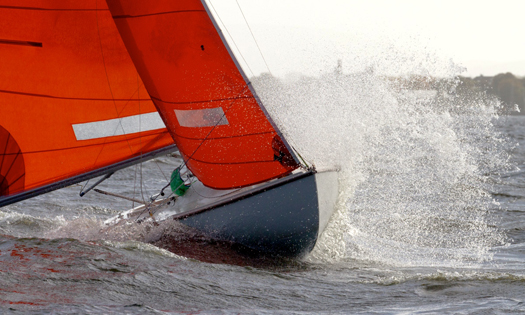
Revelling in it. Veteran skipper Vincent Delany (who also races Water Wags and Shannon ODs) puts his vintage Squib Femme Fatale (no 24) through her paces on Lough Derg. Photo: Gareth Craig/fotosail
Come to think of it, the Dragons might also have been given racing on Saturday morning if they'd been prepared to set out early and get over to the shelter of the Garrykennedy shore. But in truth, after their super sailing during Friday, the night had passed in turbo-powered conviviality, and as the Dragon crews came very slowly to life on Saturday morning on various motor-cruisers and in other accommodation, they reckoned to let the approaching storm have its way, and made arrangements to watch the rugby in the Whiskey Still in Dromineer, while other more intrepid Dragoneers battled across the lake in their vast hired Shannon motor-cruiser for a slight change of scene to watch the match in Larkin's of Garrykennedy.
But meanwhile the little Squibs were having themselves a fine old time. It was of extra interest in Dromineer, as that great stalwart of Shannon sailing Reggie Goodbody, supported by David Meredith and others, has been quietly beavering away during the past couple of years to get the Squibs going as a local class at Lough Derg Yacht Club.
As of Thursday of this week, they'd got numbers up to nine boats with others interested, which is good going from a standing start late in the summer of 2012. And though they knew that Squibs from the more experienced classes from all round Ireland would be giving them a hard time on the water, they were there ready and willing to welcome them as they drove into Dromineer on the Friday night last weekend, with twenty visiting Squibs being rigged and launched in one-and-a-half hours.
The Lough Derg people are keen to keep their new class in manageable parameters, so they've set a purchase price limit of €4,500 on people buying Squibs new to the area, which still allows for shrewd purchases in sailing centres in Great Britain, where at this time of the year it's a happy hunting ground for Squib seekers.
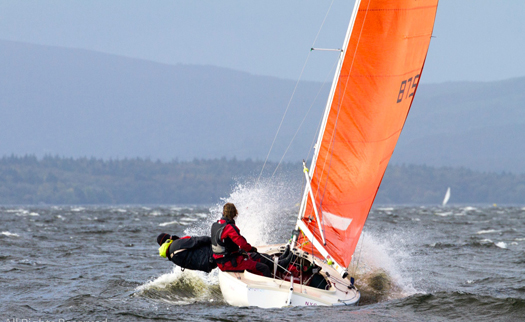
The breeze is building. One of the newest Squibs racing was Tonia McAllister's Pintail from the National YC, which finished 7th. Photo: Gareth Craig/fotosail
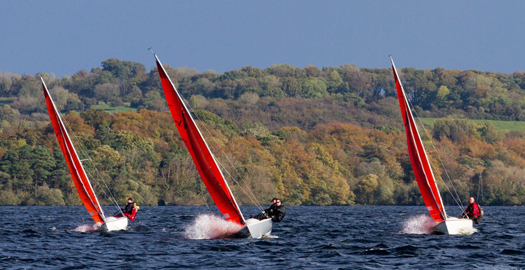 Storm? What storm? Despite dire weather predictions, at first on the Saturday morning the Squibs had perfect sailing conditions. Photo: Gareth Craig/fotosail
Storm? What storm? Despite dire weather predictions, at first on the Saturday morning the Squibs had perfect sailing conditions. Photo: Gareth Craig/fotosail
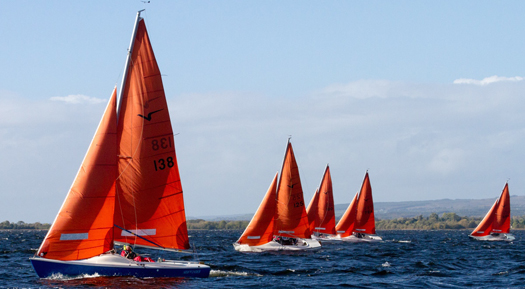 Sailing as it should be. In foreground is Rupert Bowen's Sidewinder (138, RStGYC) and beyond is clubmate Gerry O'Connor's Buzzlite (125). Photo: Gareth Craig/fotosail
Sailing as it should be. In foreground is Rupert Bowen's Sidewinder (138, RStGYC) and beyond is clubmate Gerry O'Connor's Buzzlite (125). Photo: Gareth Craig/fotosail
The attraction of the Squib for Dromineer is that it is so easily managed and maintained, a real bonus for people who may find they no longer have the energy and enthusiasm to maintain and tune a Shannon One Design, let alone the athletic ability to race one flat out. As I well recall from my own happy year of owning a Squib, they really are proper little sit-in keelboats despite being only 19ft LOA, and with our family including three small boys, a Squib proved ideal for mini-cruises along the Fingal coast and out to the islands of Ireland's Eye and Lambay, while the rapid development of the class at Howth meant we were getting good racing by the early summer of 1979.

One of the attractions of the Squib is that though she is only 19ft long, there's a proper sit-in cockpit. These are some very junior Nixons sailing on the family Squib Huppatee while returning to Howth from Ireland's Eye (hence the dinghy towing astern) in 1979. The only drawback of the Squib was she had only one tiller, so not all could steer, thus the most junior crewmember needed special consolation from his Mum.
These days the Squibs in Howth are in something of a fallow period, as many of the people who would have raced the boat in times past have moved on and up to the Puppeteer 22 which, with its little cabin and easily handled fractional rig, ticks very many boxes. However, the British & Irish Squib Championship 2015 is scheduled for Howth next June 26th- July 3rd, so doubtless that will lead to a local revival, though whether the magic number of a hundred boat racing in the same championship at the Howth venue in 1996 will be reached again is a moot point.
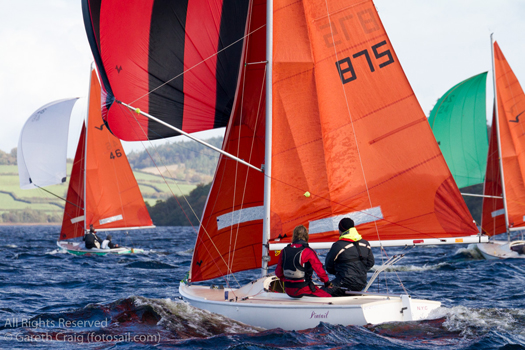
Off Dromineer, there's starting to be a real bite to the breeze as Pintail chases Femme Fatale (right) and Lola..........Photo: Gareth Craig/fotosail
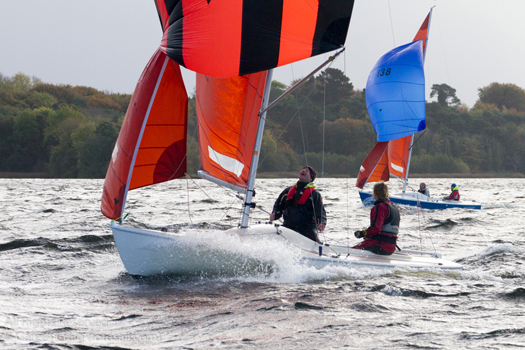
....while keeping an eye on Sidewinder off the starboard quarter. Photo: Gareth Craig/fotosail
But you never know. New boats are being built, so the class's enduring attraction is still proven, and certainly the way they got themselves back into some very confined berths at Dromineer on Saturday afternoon as further racing was being blown out was testament to their quality design and very positive handling qualities. Admittedly they may seem almost too smoothly-handling for sailing's thrill seekers, but growing classes in Dun Laoghaire and Kinsale, and the continuing health of the Squib fleets in Northern Ireland, means that the new Squib fleet at Lough Derg need never feel lonely.
That said, because the Squib has a countrywide spread, trying to keep it first and foremost a local class - as they hope to do at Dromineer - is quite a challenge. Many inshore keelboat classes today find they are becoming event boats, with crew concentrating on big happenings to which they travel perhaps every other weekend, or every three weeks or so, and they simply don't bother trying to keep up the twice-weekly commitment of club racing.

Experiment under way. Jill Fleming of Dun Laoghaire was testing a new variant on Squib sails, but although her rig looked very potent, she was back in 8th place overall with seven suits of standard tan sails ahead of her. Photo: Gareth Craig/fotosail
Certainly that's often the case with the Dragons, but then the Dragon class in Ireland offers its members a very attractive package of events all round the country at the most pleasant and glamorous sailing centres. Thus Dragon racing today in Ireland is a high-powered and potentially very expensive way of sailing, and just about as far removed as possible from Reggie Goodbody's ambitions for inexpensive Squibs at Dromineer.
He hopes to see the them develop as a good-value local class which will bring life back to Lough Derg Yacht Club during the more everyday times, when there isn't a championship going on, or it isn't the annual Lough Derg Week in August. This isn't at all the style of the Dragons' jet-setters – they're big-event performers.
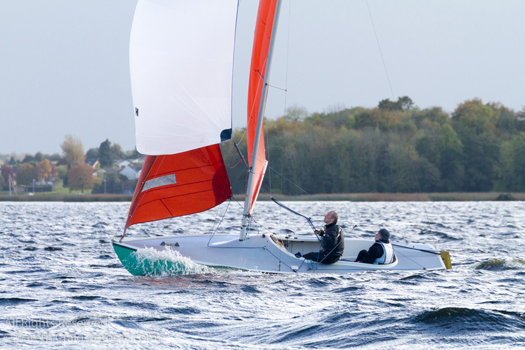
Cool sailing. One of the reasons the Squib appeals to former Shannon One Design sailors in Dromineer is that even on a busy run, you can still be relaxed and comfortable (very comfortable for the helmsman), whereas a SOD would be providing a hairy ride. Photo: Gareth Craig/fotosail
So it was fascinating to see the two very different classes sharing the lake and harbour space at Dromineer, though it was clear that if you wished to take the cheque book sailing route, the Squibs offer that as well, so Reggie and his team will have to keep the expenditure lid very firmly clamped in place.
The racing results well reflected the nationwide appeal of this event, for though the Dragons may seem to have emerged with a Dun Laoghaire dominance, winner Neil Hegarty of Royal St George YC originally hailed from Cork, and Cameron Good of Kinsale was consistent with a 6th and 3rd to take fourth behind two Dublin Bay boats.
In the Squibs, James Matthews and Rob Jacob of Kinsale racing the vintage Mucky Duck were notably consistent with a final scoreline of two firsts, a second and a third, but almost equally good were Gordon Paterson and Ross Nolan of Royal North of Ireland YC with two firsts, a second and a fifth. Another RNIYC boat from Cultra, Des and Chris Clayton's Inismara, got into the frame with the win in the final race, and the complete Squib scoreline shows the longterm health of the class, as the top six boats range in sail numbers from 24 to 820.
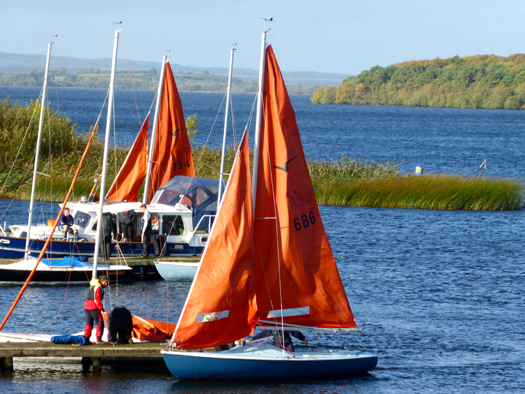
The Squibs might have been invented with Lough Derg YC's facilities in mind, as they are easy to berth on the outer harbour....Photo: W M Nixon
 ...yet even in an awkward breeze, they can head confidently for the narrow little East Dock.......Photo: W M Nixon
...yet even in an awkward breeze, they can head confidently for the narrow little East Dock.......Photo: W M Nixon
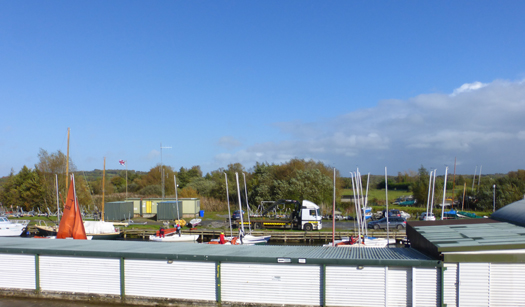
....and stay nicely under control while assessing the situation. This is Peter Kennedy's Whipper Snapper, which was top of the local boats at 11th overall in the Dromineer regatta. Photo: W M Nixon
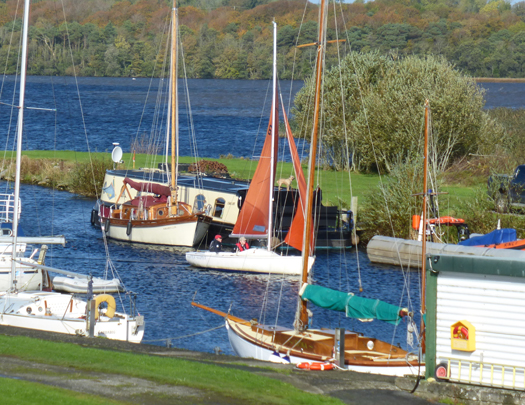
The Squib is so well mannered she'll wriggle up the most unlikely channel whatever the wind.........Photo: W M Nixon
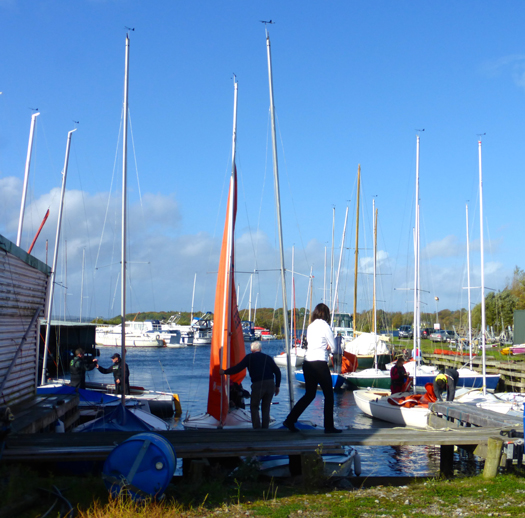
....and so Whipper Snapper reaches her berth right at the top of the dock with no bother at all. Photo: W M Nixon
As to the longterm health of the event, despite this year's problems for which we have to make some allowance for the extreme weather, there's no doubt everyone very much wants Dromineer to succeed as the venue for what has the potential to be a major and rather special keelboat regatta.
But as an outside observer who has been notably unsuccessful in running races himself, it seemed to me that when number start pushing towards the sixty mark and four classes are involved, then the visiting classes will have to expect to be bringing back-up support boats and some race officials with them. And that in turn will require a certain amount of diplomacy between the visitors and the established race administration at the hosting club. Yet that would be well worth the effort. For when the going was good at Dromineer, it was very good indeed.
LOUGH DERG YACHT CLUB KEELBOAT REGATTA 2014
International Dragon Class: 1st Phantom (Neil Hegarty, RStGYC) 3pts; 2nd Diva (Richard Goodbody, RIYC) 4pt; 3rd Jaguar (Martin Byrne, RStGYC) 7 pts; 4th Little Fella (Cameron Good, KYC) 9 pts; 5th Sir Ossis (Denis Bergin, RIYC) 13pts; 6th Cloud (Claire Hogan, RStGYC) 14pts. (15 raced).
National Squib Class: 1st Mucky Duck (James Matthews, KYC) 7pts; 2nd Quickstep (Gordon Paterson, RNIYC) 9pts; 3rd Inismara (Des Clayton, RNIYC) 15pts; 4th Fagan (Cian O'Regan, KYC) 15pts; 5th Femme Fatale (Vincent Delany, RStGYC) 15 pts; 6th Perfection (Jill Fleming, RStGYC) 17pts; 7th Pintail (Tonia McAllister, NYC) 37pts; 8th Sidewinder (Rupert Bowen, RStGYC) 40 pts (23 raced).

When the going gets too rough on Lough Derg, the prudent Dromineer mariner will seek a secure berth in the Whiskey Still to watch the rugby. Photo: W M Nixon
#squib – An overall win of Aberdeen Asset Management Cowes Week for the second year in a row has further endorsed the Squib's reputation as one of the most successful, versatile and affordable small racing keelboats on the market writes Sue Pelling.
Corinthian sailors Malcolm Hutchings and crewman Andy Ramsey sailing Lady Penelope not only won their class at Cowes Week from a highly competitive 31-boat fleet, but also won White Group overall, and were deemed overall winners of the week from the 800 plus fleet beating Adam Gosling's Corby 36 Yes! – winner of Black Group – for the second year running.
While there is no doubt that Hutchings and Ramsey's impressive sailing skill and teamwork led to their ultimate win, their passion for the 47-year-old class is what really spurs them on. As fine class ambassadors they have proved once again that winning the biggest regatta of its type in the world is not all about spending big bucks but more about good, consistent competition and maintaining a healthy class status within a fleet.
With over 500 members including a strong youth contingent, 35 fleets around the British Isles, plus boats in France, Denmark, Germany and the Caribbean, the Squib class is booming. The recent appointment of Rondar Raceboats as the new builder is good news too because it means more used boats are likely to be on the market once production of new boats is underway.
Hutchings and Ramsey, from Burnham-on-Crouch on the east coast, say that 13-year-old Lady Penelope is a fine example of the sort of results an ageing Squib can achieve: "Age is not an issue in the Squib class it's all about keeping the fleet alive. Because she is a one-design, nothing really changes, so it is possible to pick up relatively old boat for a good price and, and as long as it is maintained well, there is no reason not to do well. The key is to keep everything in tip top condition as this will ensure the Squib class is winning in years to come."
With 31 boats on the water, the Squib class was the second largest one-design fleet after the X-One Designs at Aberdeen Asset Management Cowes Week this year. Endorsing the ethos of the class, which encourages 'sailing for all', Cowes Week attracted eight under 25-year-olds including the youngest at just 12. Twenty-two of the boats had family members on board, and a third of the fleet girls including five at the helm.
Steve Warren-Smith – chairman of the class association – crewing for Sarah Everitt on Aquabat, were the only team to beat Hutchings and Ramsey in a race during Cowes Week. Warren-Smith concluded: "Winning Cowes Week in a Squib is a bit like winning the Champions League with the local village team, or winning a Grand Prix in a go-cart. It's the ability that counts, not the wallet!"
Squib Nationals Won By Vaughan Cousins on Belfast Lough
#squib – Cousins Ross and Andrew Vaughan, in 'Joint Venture', have secured the Rodgers & Browne Squib Irish Championship in mixed weather conditions at Royal North of Ireland Yacht Club at the weekend.
Supported by North Down Borough Council, the event attracted 24 boats from all over the island of Ireland. A strong local Royal North contingent was boosted by visitors from Howth, Dun Laoghaire and strong representation from Killyleagh Yacht Club and the Quoile.
Day one brought perfect sailing conditions – bright sunshine and 10-12 knots of breeze - which made for exciting, close racing and a bar full of smiling sailors when they all returned ashore. The first raced ended with a near photo finish. 'Joint Venture' (RNIYC) won by inches from 'Inshallah' (David Eccles/Phil Hutchinson, RNIYC) and 'Quickstep III' (Gordon Patterson/Ross Nolan, RNIYC). In Race 2, 'Inshallagh' secured first place and the third race was won by 'Perfection' crewed by Jill Fleming and Conor O'Leary from the RSGYC. After three races 'Aficionado' crewed by John Driscoll and David Cagney (RNIYC) were topping the leader board by one point from 'Joint Venture', followed by 'Quickstep III' in third place.
However, the tail end of hurricane Bertha made its presence felt on Sunday and the sun was replaced with continuous rain and a stiff breeze. Smiling faces were hard to find as sailors left the warmth of the club house to head out to the moorings for the scheduled three races. The north easterly wind direction meant that the race area was close to the moorings and racing got underway after a short postponement as a result of a slightly shifting breeze.
The conditions suited the Vaughans and they got line honours in all three of the day's races with 'Aficionado' clocking in three second places. 'The Worm' (Sam Lyness/Eric Hayes, RNIYC), 'Quickstep III' and 'Kerfuffle' (Jonathan Craig/Hazel Ruane, Howth YC) secured third place in races four, five and six respectively.
This left the Vaughans four points ahead of 'Aficionado' overnight and 'Quickstep III' in third place. However, the Vaughans' 10 point discard coupled with John Driscoll and David Cagney's consistent scoring meant that the race for the Championship was far from over. Race seven was certainly shaping up to be an interesting one...
Monday morning dawned bright but very breezy with a number of boats deciding not to race. 'Inshallah' led the race at the first windward mark with 'Joint Venture' and 'Aficionado' in hot pursuit. However by the next lap, 'Joint Venture' had managed to pull out into the lead. However, in the end it was 'Aficionado' that crossed the line first with 'Joint Venture' second and 'Quickstep III' in third. Second place was enough to secure the Championship for the Vaughan cousins in 'Joint Venture'.
The Squib Class will now focus its attention on the Inland Championship in Lough Derg in October.
#squib – Reigning Irish Squib keelboat champions James and Bruce Matthews from Kinsale Yacht Club will battle with past winners and recently crowned Eastern Champions, John Driscoll/David Cagney, and Northern Champions, David Eccles/Michael Wright, all of whom are in contention for the main Irish Championship prize at Royal North of Ireland Yacht Club.
As Afloat previously reported, the Rodgers & Browne Squib Irish Championship, supported by North Down Borough Council, will be held on Belfast Lough over the 9th - 11th August and will attract Squibs from throughout Ireland to compete for the trophy.
The Squib Class is one of the largest one design keelboat classes in Ireland. It is sailed by two people and is well known for its distinctive brown sails. Over the
last decade fleets have flourished at Killyleagh Yacht Club, Quoile Yacht Club, Royal St George Yacht Club and Kinsale Yacht Club, in addition to the traditional strongholds of Cultra and Howth Yacht Club.
#squib – They came from far and near to compete in the Squib South Coast Championship at glorious Glandore. Beautiful weather but light or no wind provided Principal Race Officer Nigel Kearney with challenging conditions to run the planned 3 races on the Saturday 19th July. Nigel achieved two shortened races but was forced to abandon the third race on the first beat, due to a significant fading wind shift. Patience and prayer would not suffice and all sailors were directed to the shore.
Race 1 saw Anemos, helmed by Pete Evans in first, Quickstep III helmed by Gordon Patterson second and Perfection helmed by Jill Fleming in third.
Race 2 provided a win for Lola helmed by Frank Whelan, second for Quickstep III and a third place for Anemos. Allegro improved to fourth, but posed no overall threat.
Sunday the 20th began with a light, but dying land breeze; racers wallowed around for approximately two hours for the wind gods to return to normal service. Race 4 commenced with a 10 to 15 knots of wind and sunshine – champagne sailing. From way back in the rankings, Allegro now found the groove and produced a sparkling first place finish, with Lola, and Quickstep III in close order. Effective points now were 5, 3 & 4 respectively.
In what would transpire to be the last race of the event Allegro pulled a dramatic first to Quickstep III's second, with Why Not helmed by Derek Jago, crashing the party with a third place, relegating Lola to fourth in this race.
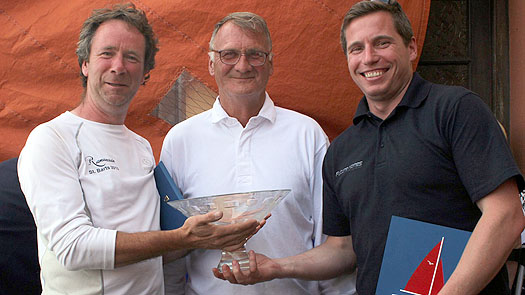
(left to right) - Colm Dunne, John Dowling Commodore, GHYC and Rob Gill. Photo: Mary Casey
Final effective points in the Gold Fleet were Allegro and Quickstep III, tied on 6 points each and Lola with 7 points, which was resolved by the scorer using appendix A8.1. The final result was first Allegro from KYC, second Quickstep III from RNYC and third Lola RSGYC.
In the Silver Fleet, John Stanley on Bateleur, KYC, took third, local hotshot Pat O'Riordan , GHYC on Blue Bottle placed second, and Colm Daly on Lazarus placed first.
#squib – In August, the Squib Class will be returning to the southern shores of Belfast Lough and the Royal North of Ireland Yacht Club.
The Rodgers & Browne Squib Irish Championship, supported by North Down Borough Council, will be held over the 9th- 11th August and will attract Squibs from throughout Ireland to compete for the national trophy.
The Squib Class is one of the largest one design keelboat classes in Ireland. It is sailed by two people and is well known for its distinctive brown sails. Over the last decade fleets have flourished at Killyleagh Yacht Club, Quoile Yacht Club, Royal St George Yacht Club (Dublin) and Kinsale Yacht Club, in addition to the traditional strongholds of Cultra and Howth Yacht Club.
The reigning champion pairing of James and Bruce Matthews from Kinsale Yacht Club will battle with past winners and recently crowned Eastern Champions, John Driscoll/David Cagney, and Northern Champions, David Eccles/Michael Wright, all of whom are in contention for the main prize.
Thomas Anderson, Commodore of the Royal North commented "I am delighted to welcome the Squib Irish Championship back to Cultra. This has only been possible with the ongoing support of Rodgers & Browne and North Down Borough Council. The Squib Class has been the backbone of our Club for several decades and it is fantastic that the fleet will be showcased through this event. In addition to the excellent sailing waters of Belfast
Lough, the Club's well known hospitality will ensure that this event will be well worth attending".
Connor Browne, Partner at Rodgers & Browne, said "We are looking forward to collaborating again with the Royal North of Ireland Yacht Club and the Squib Class to bring the Irish Championship to Cultra. North Down is a stunning location for many sporting activities, which is reflected in the demand for housing within the greater Holywood, Helen's Bay and North Down areas."







































































